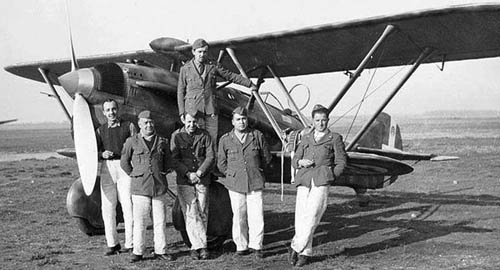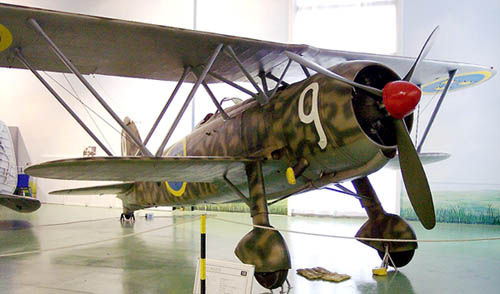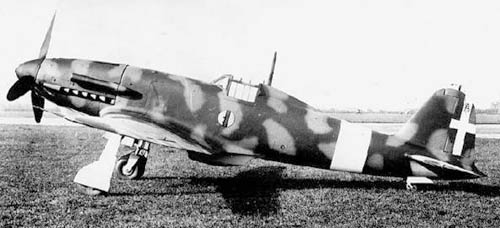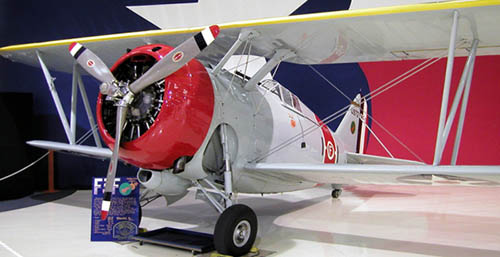Fiat Biplanes
Today, Fiat Biplanes. The University of Houston's College of Engineering presents this series about the machines that make our civilization run, and the people whose ingenuity created them.
I've often noted how automobile and airplane makers go separate ways. Still, we find exceptions. Mitsubishi has made automobiles and it made the famous Zero, the all-too-effective Japanese fighter in WW-II. But it's a huge conglomerate of many companies.
Italy's Fiat Company is a more interesting exception. Fiat, known for its cars, built airplanes from 1924 to '64. Its aviation division finally split off as a new Company. But Fiat began with its CR biplanes. CR stood for Caccia Rosatelli. The designer was Celestino Rosatelli and caccia meant hunter.
The open-cockpit CR biplanes were throwbacks in the aerial world, but Fiat left the boxy shape of WW-I fighters. Fiat had a fine flair for design. And these snazzy relics played a role in WW-II -- flying against the new breed of low-winged fighter planes.
The CR-32 design had congealed by 1934. It was a pretty airplane with natty spats on its fixed landing gear. Its inline liquid-cooled engine had four times the power of its WW-I counterparts. Yet its 224 mile-an-hour speed left it far slower than the Spitfires or Messerschmitts just coming on the scene.
Still, it had a biplane's special maneuverability. It first saw combat when the fascists used it in the Spanish Civil War. There it outclassed the opposing Russian Polikarpov biplane. It even held its own again the much faster Russian monoplanes when they arrived. As WW-II began, Italy kept using CR-32s for troop support in Africa. They also sold them to the Hungarian Air Force.
In 1939, Fiat unveiled its CR-42 series -- still an open-cockpit biplane! Its new radial engine only slightly increased its speed. From then 'til 1943, Fiat made some 1800 CR-42s and sent them off to fight the far faster Mustangs and P-38s.
By the way, changing from a liquid-cooled inline engine to an air-cooled radial one reflected a tension that lasted through the whole history of propeller airplanes. The Wright brothers used an inline engine. Five years later, Bleriot used an air-cooled one. Neither type ever did gain ascendancy over the other.
The CR-42s did well for a while in North Africa; then newer fighters began slaughtering them. Fiat took one more shot at making fighter planes. In 1943, their G.55 came out. It finally had the look of a WW-II fighter -- a sleek monoplane with performance that well might've stood up against the late Allied fighters. But, it took too many man-hours to make it. Fewer than two hundred were built before the Allies liberated Northern Italy, then occupied by Germany.
And we're left to ponder those old Fiat biplanes -- defying common sense. One thinks of Snoopy, trying to fight the Red Baron. They truly did heave the dying gasp of a fading past.
I'm John Lienhard, at the University of Houston, where we're interested in the way inventive minds work.
(Theme music)
G. Punka, Fiat CR 32/CR 42 in Action. (color by Don Greer and Richard Hudon, Illustrations by Richard Hudson and Lori Basham (Carrollton, TX: Squadron/Signal Publications, Inc., 2000), No. 172.
For more on the three Fiat airplanes discussed here, see:
https://en.wikipedia.org/wiki/Fiat_CR.42
https://en.wikipedia.org/wiki/Fiat_CR.32
https://en.wikipedia.org/wiki/Fiat_G.55
Top three images below are courtesy of Wikepedia. Bottom photo is by JHL

Fiat CR-32 in the Spanish Civil War
Fiat CR-32
Fiat G.55 
The American Navy Grumman F3F, last American biplane fighter, was withdrawn from service in 1941 and never saw combat. Its performance data were similar to those of the Fiat CR-42.